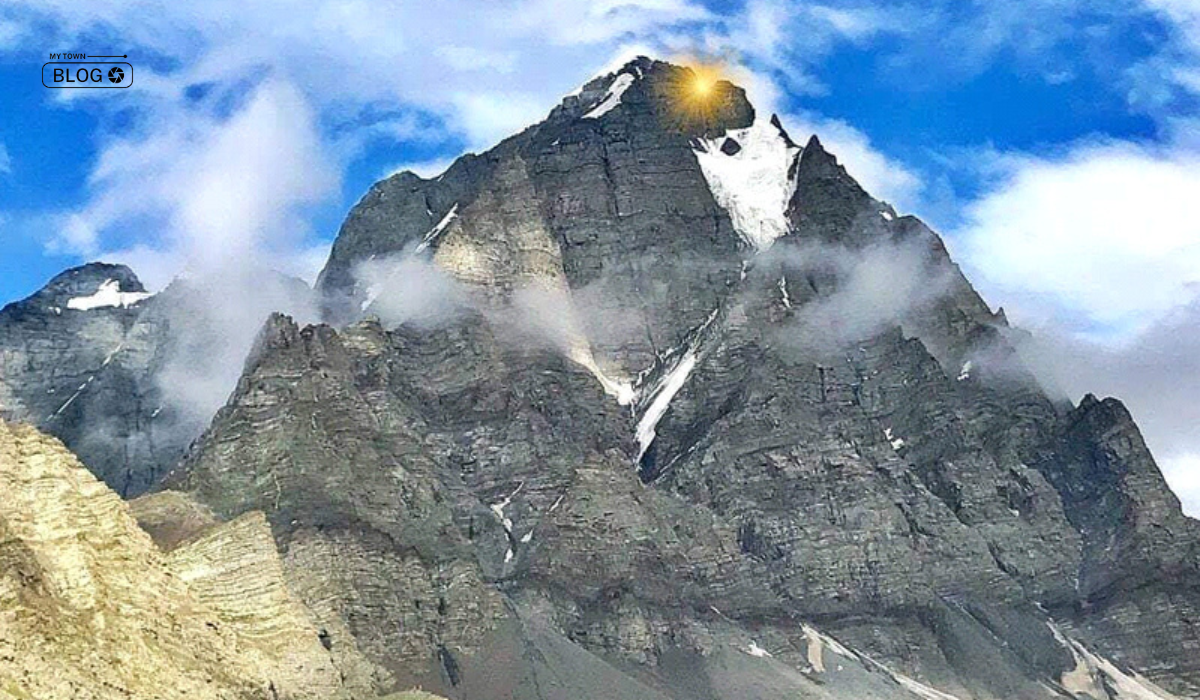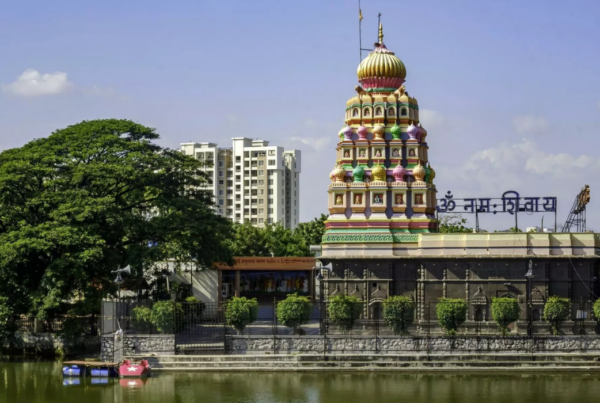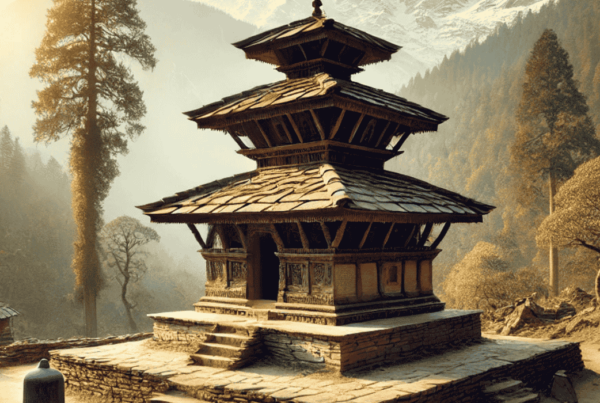Some Hindu devotees journey to Himachal Pradesh annually to participate in the well-known Manimahesh Kailash Yatra. Janmashtami marks the beginning of this three-day holy journey, which continues on Radhashtami. The trek covers 13 kilometers. The destination is the serene Manimahesh Lake nestled in the Bharmour area of Chamba district.
Legend has it that Lord Shiva manifests in the form of “Mani” in Manimahesh, located approximately 85 kilometers from Chamba city. Encircled by the majestic Dhauladhar, Pangi, and Zanskar mountain ranges, this sacred peak is referred to as Manimahesh-Kailash. People of faith have been making this thrilling travel for thousands of years, believing Chamba to be the residence of Lord Shiva, hence the name “Shivbhoomi.”
History and legend surround the Manimahesh Yatra’s beginnings, with stories of Lord Shiva making multiple heavenly visits to his followers in this area. At 13,500 feet above sea level, the natural lake helps the place’s magical atmosphere, which is thought to be evidence of a higher force.
The lake’s water level suddenly rises on the lucky day of Ashtami, even before the traditional bath commences, which is one of the pilgrimage’s unique events. The event confuses researchers, who have been unable to find the reason for it. The reason behind this unexpected spike in water levels is still unknown, as is the resulting decline in water levels during Ashtami.
For those making the journey, the holy Manimahesh Lake has even more meaning because it is believed that Lord Shiva personally executed meditation there.
Visit The Historic Brahmani Devi Mandir Before The Journey:
Without making a trip to the Brahmani Devi Temple, the Manimahesh Kailash Yatra seems incomplete. This temple, which is only 4 kilometers from Bharmour, is very important to travelers. It is traditional for visitors to take a bath at the blessed pool next to the temple before starting the yatra. It is thought that this procedure is necessary for the trip journey to be fully completed.
Starting On A Faith-Based Journey:
Hindu texts describe Mount Kailash as Manimahesh-Kailash. It is bound by the Himalayan mountains of Dhauladhar, Pangi, and Zanskar. A lot of travelers come here to honor Mount Kailash after bathing in the holy waters of Manimahesh Lake during festivals that include Sri Krishna Janmashtami (Bhadrapada Krishna Ashtami) to Sri Radhastami (Bhadrapada Shukla Ashtami). There is lots of adventure on the route to Manimahesh Lake, which passes through mountains, valleys, and rivers. People say that the Manimahesh Yatra has similarities to the Amarnath Yatra. People who are unable to make the trek to Amarnath sometimes go to Manimahesh Lake to take an important bath.
Nowadays, reaching Manimahesh Lake has become more accessible with helicopter services available from Bharmour to Gaurikund during the yatra. For trekking enthusiasts, tents are set up for accommodation around Hadsar, Dhancho, Sundarasi, Gaurikund, and Manimahesh.
Legend has it that Lord Shiva and Mother Parvati used to play here, which is why people call this location “Shiva’s Chaugan”. Those who participate in the Manimahesh Yatra usually explore the religious lake three times after taking a dip in it and paying respect to the four-faced stone image of Lord Shiva nearby. Residents believe that the Manimahesh Kailash mountain shields them from calamities, leading them to venerate this massive mountain.
To ensure the convenience of devotees during the Manimahesh Yatra, residents (referred to as Gaddis) traditionally ascend the mountains with their sheep before the yatra begins. They clear the path leading to Manimahesh Lake.
According to traditions, Lord Shiva and Mother Parvati used to have fun here, which is why people call this place “Shiva’s Chaugan”. Following a dip in the famous lake and a visit to the next-door four-faced stonework of Lord Shiva, travelers in the Manimahesh Yatra frequently spend three days visiting the site.
Navigating To Manimahesh Lake:
Manimahesh Lake can be reached by travelers and hikers via a variety of paths. Kugti Pass is usually used by hikers traveling from Lahaul and Spiti to get to Manimahesh. Travelers from Kangra and Mandi often opt for the route via Kavarsi or Jalsu Pass. Another common route is through Chamba and Bharmour, which provides relatively easy access to Manimahesh.
Passengers traveling via Bharmour can take a bus to Hadsar. From Hadsar, pilgrims and trekkers need to continue their journey to Manimahesh on foot. Along the way from Hadsar to Manimahesh lies Dhancho, where most travelers choose to rest for the night. If time permits during the Manimahesh Yatra, visitors can also explore a beautiful waterfall located near Dhancho.
En route to Manimahesh Lake, travelers encounter two significant religious water bodies named Gauri Kund and Shiv Krotri, situated about one kilometer before reaching the lake. According to mythological beliefs, Lord Shiva and Mother Parvati alternately bathed in these two reservoirs. Female pilgrims typically begin their journey by bathing in Gauri Kund, while male pilgrims start at Shiv Krotri reservoir.
Alternatively, travelers can reach Manimahesh Lake by trekking. The first route passes through Hadsar and Dhancho, offering various facilities for travelers and devotees. Due to its accessibility and availability of amenities, travelers often prefer this route.
The second route, preferred by many trekkers and adventure seekers, passes through Holi Village. However, facilities are scarce along this route until reaching Manimahesh. Despite this, travelers are rewarded with stunning views of Manimahesh Lake from higher vantage points while taking this route.
Spectacular Sight Of Sapphire:
The Himachal Government has bestowed upon this mountain the name “Turquoise Mountain,” also known as Vaiduryamani or Neelmani. When the sun rises behind Mount Kailash in Manimahesh, the entire sky takes on a blue hue, and the rays appear in shades of blue. Believers attribute properties akin to sapphire to Mount Kailash, causing the collision of sunlight to create this mesmerizing blue spectacle.
Interesting Information About The Manimahesh Kailash Peak:
There is a belief that no one has successfully climbed the peak of Manimahesh Kailash so far. Legend has it that decades ago, a Gaddi attempted to ascend the mountain with a group of sheep but met with failure and eventually turned into stone along with the sheep. There are also tales of a snake attempting the climb, only to suffer a similar fate of turning into stone. These stories contribute to the mystique surrounding the unconquered peak of Manimahesh Kailash.
Lord Shiva desired to keep the peak visible only to himself.
Past unsuccessful attempts have marked hiking to the Manimahesh Kailash peak. It’s speculated that by navigating the N Ridge and E Wing up to the Nanoni Valley and descending to Kugti Village, it might be feasible to ascend and descend the peak within 3 days. People consider the condition of the peak at such mountainous heights challenging.
The Manimahesh Kailash peak abruptly descends into the lake nestled in the mountain’s lap. Believers hold that it symbolizes Lord Shiva seated on the throne atop the Manimahesh Kailash peak, with the natural light resembling the gem worn around the neck of Sheshnag.
Legend has it that the height of this mountain remains unmeasured to this day. While climbing this Kailash peak isn’t considered difficult, none of those who ventured up ever returned. Local lore suggests that despite the conquest of Mount Everest, scaling the Manimahesh Kailash peak isn’t as straightforward. There’s a tale of a Gaddi who attempted the climb, vowing to sacrifice a sheep or goat at each step of the way but turned into stone before reaching the summit. The sheep accompanying him suffered the same fate, and it is said that some of these stone formations still exist in the area.
Ideal Time To Explore Manimahesh:
Tourists and pilgrims can visit Manimahesh any time from April to November. However, from December to March, heavy snowfall blankets the area, including the lake itself. These harsh winter conditions make visiting during this time not recommended. The months of June to October witness a large influx of devotees who come to visit Manimahesh Lake, drawn by its spiritual significance and serene beauty.
Suggestions For Exploring Manimahesh Lake:
It’s a great experience to travel while attending the Manimahesh Fair, but be careful—there are a lot of fanatics around. If you intend to visit Manimahesh outside of the fair, make sure you bring food, drinks, and comfortable clothing because there are not many food and drink options available in part of the fair.
Be sure your exploring equipment is in working order before starting the Manimahesh trip. It’s best not to walk alone during the off-season or when there is a lot of snowfall because these conditions might make trekking difficult. Follow the trekking requirements and always go in the company of other experienced hikers or guides.
When starting your trip, ensure that you fully charge all your electrical equipment, including smartphones, stabilization devices, photographic equipment, drones, and other gadgets. Higher altitudes might not have access to charging stations. An amazing opportunity to view the Milky Way at night is provided by Manimahesh, which makes camping at night a perfect choice.
Keep in mind that there can be issues with coverage for mobile networks at Manimahesh, so consider carrying a satellite phone if you can to ensure you can stay in contact.
Manimahesh Trek:
Day 1: Hiking to the 2,280-meter Dhancho
We’ll eat an early breakfast today and then begin our walk. We’ll check out and drive to Hadsar, which marks the end of the road access. We’ll start our 7-kilometer climb to Dhancho from there. We’ll have a well-earned lunch when we get to Dhancho in the middle of the day, and the rest of the evening is ours to relax. We’ll spend the night camping at Dhancho.
Day 2: Travel 14 km on foot to reach Manimahesh Lake
We’ll go out on a 14-kilometer hike to the majestic Manimahesh Lake, which hides away at 4,080 meters, after breakfast. We’ll enjoy an informal lunch and take in the lake’s peaceful beauty. Later in the day, we will climb back to the Dhancho base camp and set up camp there.
Day 3: Return to Bharmour and Chamba
In the morning, we’ll trek back 14 km to Hadsar. From there, we’ll drive back to Chamba via Bharmour, concluding our memorable journey.
Hotels in Bharmour:
Hotel Bharmour View
In Brāhmaur, Hotel Bharmour View provides lodging with room service and a front desk open around the clock. Free WiFi is available to visitors everywhere on the location. There’s also a restaurant on site that serves real Indian food, and there are free private parking spots for visitors.
Hotel Bharmour View in Brāhmaur offers accommodations with restaurant service and a 24-hour front desk. All around the site, guests can access free WiFi. Additionally, there’s a restaurant on the property that offers traditional Indian food, and free private parking is available for visitors.
Bharmour villa
Bharmour Villa, set away in the Himachal Pradesh region’s Brāhmaur, offers a haven of peace surrounded by lush gardens. Guests can explore the areas surrounding the hotel by hiring a car or by taking advantage of the free private parking offered.
The property offers private bathrooms in each room, and for more privacy, several of the rooms even have rooftops facing the garden.
The suitable for families restaurant at the villa offers delicious American food and is open for dinner, lunch, and brunch.
Moreover, guests can partake in rejuvenating yoga classes offered on-site and unwind by the outdoor fireplace at the villa complex for a truly tranquil experience.
Hotel Mahadev Bharmour
Hotel Mahadev Bharmour provides accommodation in Brāhmaur, offering a comfortable stay for guests. This three-star hotel has free WiFi throughout and functional features like room delivery and a front desk that is open around the clock. During their visit, guests can enjoy incredible vistas of the hills.
For ease of storage, a closet is provided in every hotel room. To further ensure a comfortable and restful stay, guests may take advantage of a flat-screen TV, private bathroom facilities, and a balcony with enticing city views.
The Northern Country Homestay
The North Village House, which is located in Bajoli in the Himachal Pradesh location, has a beautiful atmosphere and a terrace with amazing panoramic mountain views. Free private parking, free WiFi, and an outdoor area are available for guests to enjoy at the hotel.
Over guests can enjoy a flat-screen TV and bed linens and towels provided by the homestay.
The Hidden Crest
The Hidden Crest in Chhatrari has guestrooms with a warm terrace and breathtaking views of the mountains. Every apartment includes a balcony with breathtaking views for visitors. In addition, it features multiple features including an electric hair conditioner and shower in a private bathroom and a television with a flat screen.
For extra ease, guests may request bedding and towels for an additional fee.
Guests can choose from a wonderful vegetarian meal or a full English/Irish breakfast at the guesthouse. In addition, visitors can benefit from the common lounge space and the adjacent hiking and bicycle routes.
Concerning Manimahesh Trek (FAQs):
What is the Kailash hike in Manimahesh?
Hindu pilgrims drive the Manimahesh Kailash Yatra, a well-known devotional journey, to reach Manimahesh Lake after a 13-kilometer trek in Himachal Pradesh.
What time is the journey happening?
Usually in August or September, the journey starts on Janmashtami and ends on Radhashtami.
How can one reach Manimahesh Lake?
Pilgrims can trek from Hadsar or access Bharmour by road.
What facilities are available along the trekking route?
Campsites like Dhancho offer accommodation and food, with helicopter services also available during the yatra season.
Is trekking to Manimahesh Lake possible in winter?
High snowfall from December to March makes it advisable to avoid.
Before going on walks, one must take safety measures.
To protect your safety, double-check your climbing equipment, bring warm clothing, and hike with friends or guides.
What landmarks are along the trekking route?
Pilgrims encounter the Brahmani Devi Temple, Gauri Kund, and Shiv Krotri, significant sites on the pilgrimage journey.
Also Read: Kinner Kailash Trek: History, Trek Permit, Tracking Tips, And How To Reach








